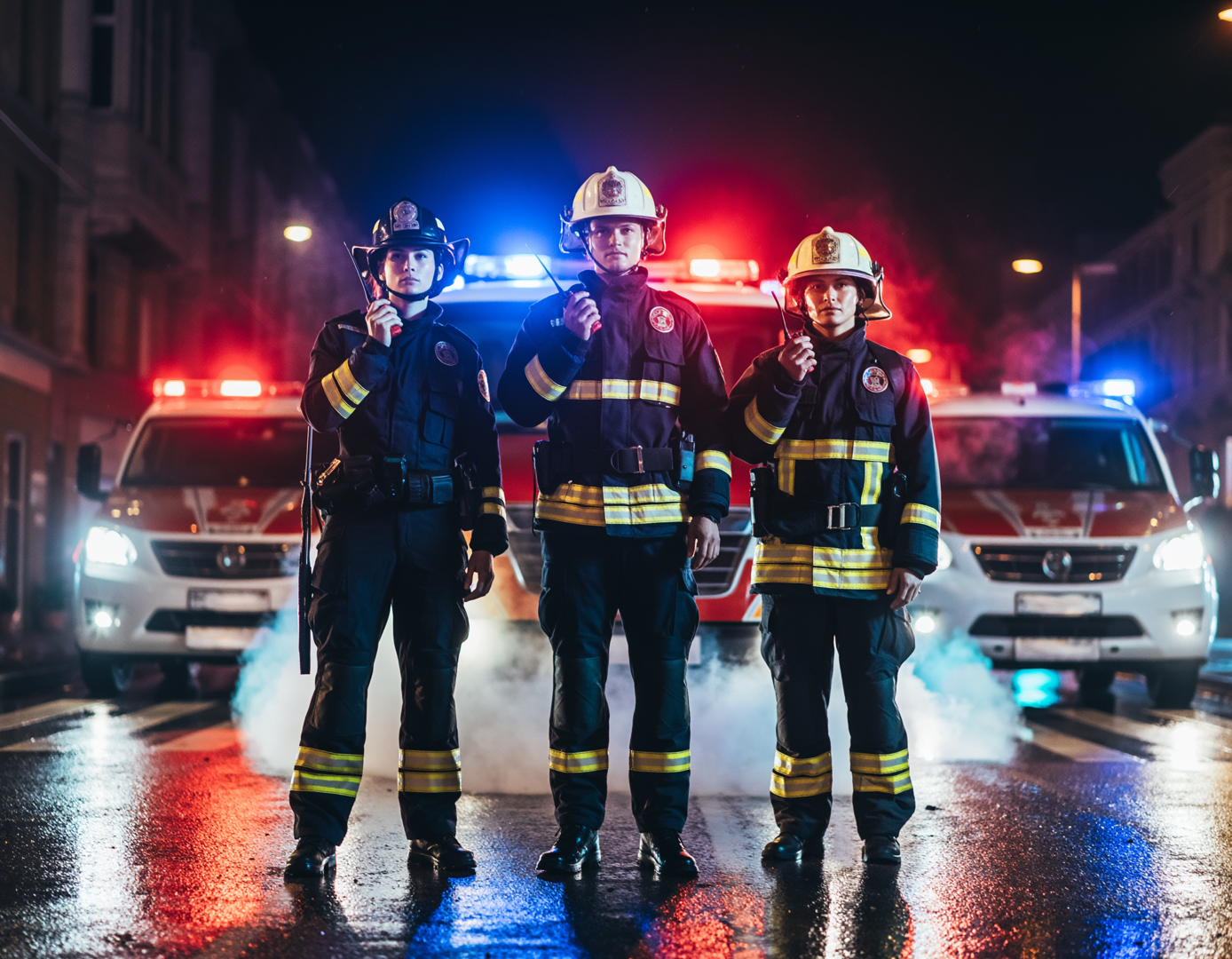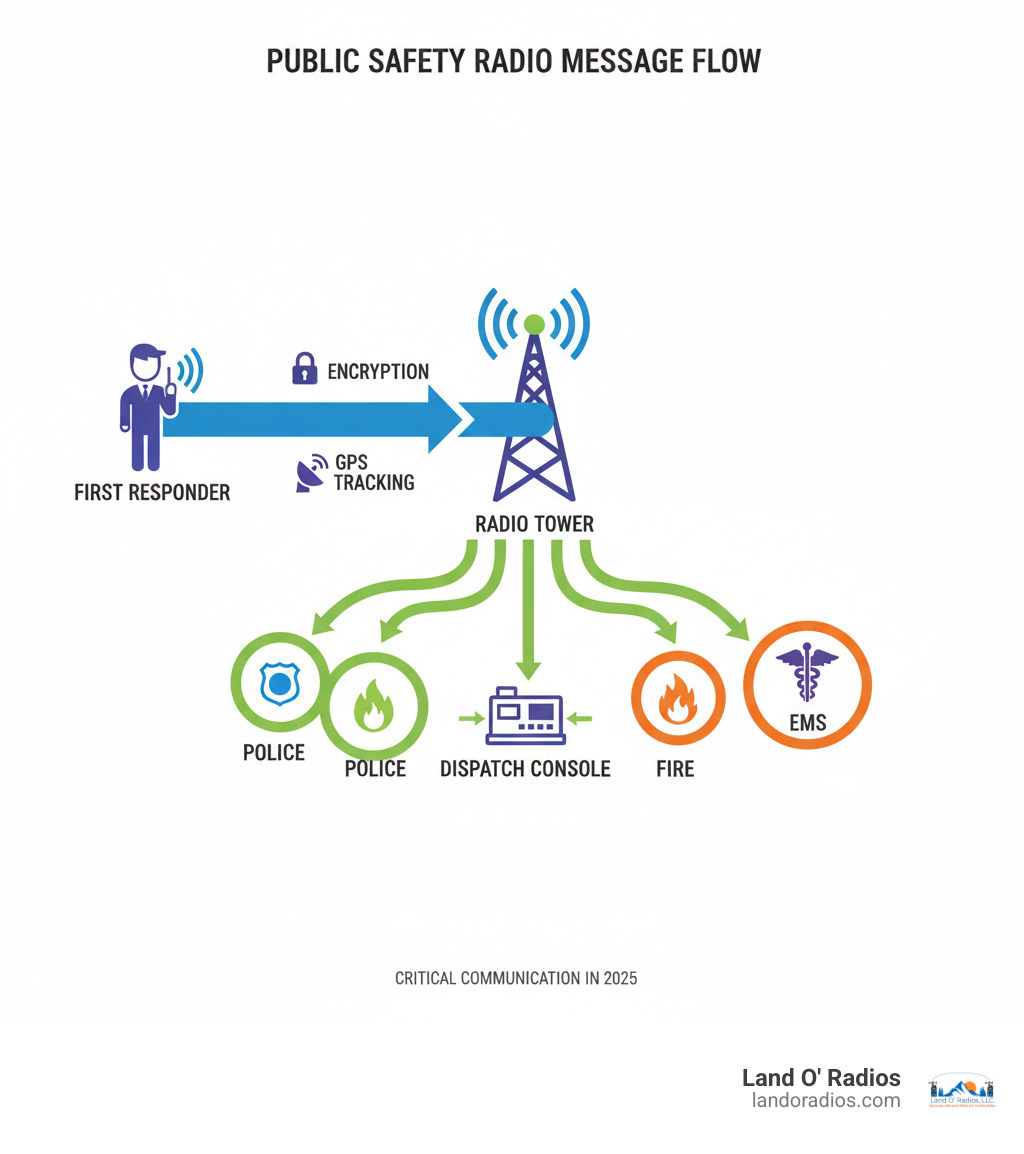The Lifeline When Every Second Counts

Public safety radios are specialized two-way communication devices that provide reliable, instant connectivity for first responders like police, fire departments, and emergency medical services (EMS). Unlike smartphones, these mission-critical tools operate on dedicated networks, ensuring communication works when commercial networks fail. They offer exceptional coverage and are built to survive the most demanding conditions.
Key features include:
- Interoperability: Seamless communication across different agencies.
- Advanced Encryption: Protects sensitive transmissions with AES-256 security.
- Exceptional Durability: Built to military (MIL-STD-810G) and fire-service (NFPA) standards.
- Priority Network Access: Guarantees a connection during major emergencies.
- Extended Battery Life: Designed for long shifts without recharging.
When an emergency happens, there's no room for dropped calls. As one public safety professional put it: "When communication technology is always evolving, one thing remains constant: there is no substitute for voice." That's why thousands of agencies rely on digital two-way radios to coordinate life-saving responses every day.
I'm Rene Fornaris, Vice President of Land O' Radios. With over a decade of experience, I'm here to help you understand how public safety radios keep teams connected when it matters most. This guide will cover everything from choosing the right radio to understanding the technology that makes these devices the gold standard for mission-critical communication.

The Gold Standard: Why Digital Radios Are Essential for Public Safety
When a crisis unfolds, first responders need communication that is instant and reliable. Unlike smartphones that rely on cellular towers that can become overloaded, public safety radios operate on dedicated networks built for emergencies. When commercial networks go down, these radios keep working, making them a lifeline for police, fire, and EMS teams.
Modern digital systems do more than just transmit voice; they create a complete communication ecosystem. Understanding what is digital radio technology helps explain why it has become the gold standard for mission-critical operations.
Why Digital Radios Enable Teamwork
At the heart of public safety communication is a standard called Project 25 (P25). Think of P25 as a universal language that allows all P25-compliant emergency radios to communicate, regardless of the manufacturer. Before P25, a police officer's radio often couldn't talk to a firefighter's, creating dangerous communication gaps. P25 solved this by ensuring guaranteed interoperability.
This standard also delivers superior audio quality by cutting through background noise, offers advanced 256-bit AES encryption to secure sensitive communications, and supports multiple frequency bands (UHF, VHF, 700/800 MHz) for reliable coverage in both urban and rural areas. Importantly, P25-compliant equipment is often eligible for federal grants, helping agencies afford crucial upgrades.
The real power of P25 shines during multi-agency incidents. Imagine a major highway accident involving police, paramedics, and firefighters. P25 technology allows commanders to create flexible talk groups on the fly, bringing different agencies into a single, unified channel. This seamless teamwork saves time and lives by ensuring everyone has the same information, allowing responders to focus on their mission, not their equipment.
Choosing the Right Radio: Types of Public Safety Radios Explained
Not all public safety radios are the same. The needs of a patrol officer differ from those of a fire chief or a paramedic. Choosing the right radio type—portable, mobile, or advanced—is crucial for operational success.
Portable Radios: The Everyday Hero’s Tool
Portable radios are the handheld workhorses of public safety. Compact, tough, and reliable, they are essential for responders in the field. These radios are built like tanks to military-grade standards, handling drops, water, and dust with ease. They feature long-lasting batteries for extended shifts and simple, tactile controls that work even with gloves on. For teams new to this equipment, our guide on Two-Way Radio Training: Best Practices for New Users can help get everyone up to speed.
Mobile Radios: Power and Reach on the Move
For more power and range, mobile radios are the answer. These vehicle-mounted units are installed in patrol cars, fire engines, and ambulances. Operating at a higher wattage, they provide a stronger signal over larger territories, which is crucial for agencies covering vast areas. Since they are powered by the vehicle, battery life is not a concern, and external antennas maximize their reach. Their powerful speakers cut through engine and siren noise, ensuring every message is heard.
The Next Generation: Advanced Connectivity Radios
The world of public safety radios is evolving, with traditional Land Mobile Radio (LMR) technology merging with modern broadband. These next-generation radios add LTE connectivity, allowing them to switch seamlessly to cellular networks when outside of radio range. This hybrid approach enables Push-to-Talk over Cellular (PoC) and game-changing data capabilities like real-time mapping and video feeds. As seen in other industries, smart communications are revolutionizing safety, giving first responders unprecedented situational awareness.
Built for the Toughest Moments: The Technology Behind Public Safety Radios
Public safety radios must perform flawlessly in hazardous and unpredictable environments. This reliability is achieved through cutting-edge technology and incredibly robust design.

Keeping Conversations Secure and Private
In public safety, privacy is non-negotiable. Modern radios feature 256-bit AES encryption—the same level trusted by military agencies—to make conversations virtually impossible to intercept. Additionally, Link Layer Authentication ensures that only authorized devices can access the network. This multi-layered security protects tactical information and maintains operational integrity.
Coverage You Can Count On—Anywhere
A radio is useless without a signal. Public safety radios use multiple frequency bands (VHF, UHF, 700/800 MHz) to ensure reliable coverage everywhere, from dense urban cores to widespread rural areas. For large structures like hospitals or high-rises where signals can weaken, Bi-Directional Amplifiers (BDAs) and Distributed Antenna Systems (DAS) are used to boost and distribute signals. Many jurisdictions, including Miami-Dade County, now mandate these systems to ensure first responders stay connected inside buildings.
Durability That Goes the Distance
First responders need equipment that can take a beating. Public safety radios are engineered to meet extreme durability standards:
- MIL-STD-810G: Withstands shock, vibration, extreme temperatures, and humidity.
- IP67/IP68: Rated for submersion in water without failing.
- NFPA 1802: Certified for use in the extreme heat of a fireground.
- HazLoc Div1: Guaranteed not to create sparks in explosive atmospheres.
This proven toughness ensures radios keep working in the worst conditions, as documented in real-world events like the Fremont, Nebraska floods. You can learn more from the APX 6000XE Fremont Nebraska Case Study.
Beyond the Radio: Building a Complete Communications Ecosystem
A public safety radio is the core of an emergency communication system, but its true power is open uped with the right features, accessories, and support. Building a complete ecosystem ensures your team is prepared for any situation.

Must-Have Features and Accessories
Modern radios are packed with features that improve safety and efficiency. GPS location tracking allows dispatch to see a responder's exact location, while Bluetooth enables the use of wireless headsets and speaker mics for hands-free operation. Wi-Fi capability simplifies firmware updates, and an Adaptive Audio Engine automatically adjusts volume based on background noise.
The right accessories are just as important. Remote speaker microphones, noise-canceling headsets, and high-capacity batteries with intelligent chargers are essential add-ons. At the center of it all is the dispatch console, where operators manage communications and coordinate resources. For agencies with vehicles, professional installation and integration services ensure mobile radios and antennas perform optimally.
Understanding the difference between professional radios and consumer devices is key. Our guide on the Top Five Differences Between Two-Way Radios and Walkie Talkies can help clarify your needs.
Planning and Maintaining Your System
Deploying a radio system requires careful planning. It starts with system design custom to your jurisdiction's geography and coverage needs. Budgeting should account for equipment, infrastructure, licensing, and ongoing maintenance. Fortunately, federal grants are often available to help offset these costs. Finally, network setup and user training are critical to ensure your system is integrated properly and every team member knows how to use it effectively under pressure.
Frequently Asked Questions About Public Safety Radios
Here are answers to some of the most common questions we hear from agencies considering a radio system upgrade.
Why not just use smartphones for emergency communication?
While smartphones are useful, they can't replace public safety radios for mission-critical voice communication. Here’s why:
- Reliability: Commercial cellular networks become overloaded or fail during major emergencies. Radio networks are built to stay online.
- Priority Access: Radio traffic for first responders is always prioritized. Your call will get through.
- Durability: Radios are built to military standards to withstand drops, water, and extreme temperatures. Smartphones are fragile in comparison.
- Instant Communication: Push-to-talk connects you to your entire team instantly. No dialing or waiting.
- Direct Mode: Many radios can communicate directly with each other even if all network infrastructure is down.
What does interoperability mean, and why is it crucial?
Interoperability is the ability for different agencies (police, fire, EMS) to communicate seamlessly, even if they use different radio brands. It's crucial because emergencies often require a multi-agency response. Standards like P25 create a common platform, ensuring a police officer from one city can talk directly to a firefighter from another during a joint operation. This prevents the communication breakdowns that have hampered responses in past emergencies.
How much do public safety radio systems cost?
The cost varies widely based on an agency's specific needs. Key factors include:
- Equipment: The number and type of portable and mobile radios.
- Infrastructure: The cost of towers, repeaters, and dispatch centers needed to provide coverage.
- Ongoing Costs: Maintenance, software, accessories, and repairs.
While the investment can be significant, federal grants are often available to help public safety agencies acquire compliant communication systems. Reliable communication is not an expense—it's an essential investment in the safety of responders and the public.
Conclusion: Your Trusted Partner in Public Safety Communications
When every second counts, communication cannot fail. Public safety radios are the essential lifelines that connect first responders, ensuring coordinated and effective responses. Throughout this guide, we've seen how P25-compliant digital technology enables seamless interoperability, how rugged engineering provides best durability, and how a complete ecosystem of features and accessories improves safety and efficiency.
At Land O' Radios, we have over a decade of experience serving first responders in South Florida, from West Miami to the greater Miami-Dade County area. We understand that reliable communication is built on trust, and we are committed to providing not just equipment, but complete solutions backed by expert guidance and support.
The future of public safety communication will continue to evolve, but the core principles of reliability, security, and instant connectivity remain constant. Whether you are upgrading an existing system or planning a new deployment, our team is here to help you steer every step, from design and budgeting to training and maintenance.
Ready to improve your agency's capabilities? Explore our curated selection of commercial radios and find why organizations across South Florida trust Land O' Radios to keep them connected. Because when lives are on the line, your communication system is your lifeline.
Stay calm and radio on.








